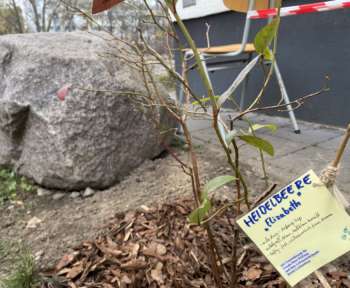While the digital world is new for most German schools, the Pennsylvania Cyber Carter School only provides online schooling. We made acquaintance with its’ headmaster.
by Ronja Zemmrich and Tobias Westphal
With regard to digitalisation, Germany performs poorly. It ranks only slightly above the EU average in the Digital Economy and Society Index (DESI), taking the eleventh place far behind Denmark, Finland, Sweden and the Netherlands.
Given the circumstances, the coronavirus has all of a sudden forced German schools to step into a complete new territorium: the digital world. Developing concepts of how classes can be held from distance was now on the agenda for the first time.
Due to the fact that German schools are equipped appallingly with technology, the lockdown started as a disaster for most of them. Most Learning Management Systems, including Lernraum Berlin, the HPI Schul-Cloud and Mebis, were not prepared for the bandwidth suddenly needed. This resulted in servers being inaccessible or too slow to use, in order to have a productive school day. Moreover, the registration and set up process wasn’t yet automated. It took weeks for all new students and schools to be registered by hand.
Those preparations should have been done before the world was shut down due to a pandemic. However, this was not the case. Only a few schools had their own systems available and were prepared for three months of homeschooling.
In a study, 71 per cent of respondents reported to the researchers of appinio that they do not believe that German schools are equipped well enough to offer homeschooling.
The polar opposite to this is the Pennsylvania Cyber Charter School, which only provides digital online schooling. We were able to make acquaintance with Brian Hayden, CEO and headmaster of just mentioned school. We talked to him about the teaching methods at his school, as well as how he handles the problems we experienced in the past month.

Herderzeitung: Brian, thank you for taking the time to talk with us. Yours is one of America’s first and most advanced total-digital schools. What would you say makes your school unique?
Brian Hayden: We are a Kindergarten through twelfth grade public school serving over 11,000 students all over Pennsylvania. We operate digitally the same way a traditional school does: We have teachers conducting classes within a cyber classroom. The teachers lecture, ask questions, give assessments – then the students respond. They can either talk through their microphones or respond via chat. Just like this!
Did the pandemic have any impact on you? Was there an increase in applications?
This was the first year we exceeded our enrollment limitation – primarily due to the pandemic. Even though they are digital, we still have class sizes (24 in a live classroom) to keep the teaching manageable. When school started in late August, we had over 2300 students on a waiting list. By law, we must randomly choose students so we used a computer program to randomly pick numbers that we had assigned to students. We then offered them a seat.
2300 students? Wow, that’s a lot!
Yes, 2300 students was a large list. We were ultimately able to work through the list. Some students chose to enroll in a different school, others came here when given the opportunity. We no longer have a waiting list, but that could change after we return from holiday break in January.
You are a regular public school. Hence, it doesn’t cost anything to enroll with you. However, it must be expensive to acquire devices for such a large number of students. How is the necessary equipment financed?
Since we are a public school, the home school district reimburses us based on the amount of money they spend to educate a student. Generally, it costs 12,500 USD to send a student here. The families pay nothing.
Today, you’re one of the most advanced online schools. What impuls pushed you to open a school that operates purely digitally? Please tell us about the history of your school.
PA Cyber held its first classes in 2000, so this is our twentieth year of teaching. We have an interesting story. The town we are located in (Midland, Pennsylvania) had a large steel mill that closed in the mid-1980s. This led to many families having to move to find better work and eventually they had to close the local high school because they didn’t have enough students. For a few years, students attended school in the next state, Ohio.
When Pennsylvania passed a law allowing for charter schools (public schools operated by a non-for-profit organization instead of a community), the local leaders found this a way to bring their students back to Pennsylvania. The first year, there were only a few hundred students and there was really no online curriculum available so they had to create much of what we do today.
They switched to an online solution because there were not enough students to open a high school building up. Being digital gave students outside of Midland the change to enroll. This meant that all students could have a full school experience, with many classes to choose from, activities, and better support.
That’s exciting. What was it like for your students in the first weeks? Did the students and parents have any doubts about whether it would work?
For our returning students, this is just how they attend school, but it has all of the excitement and questions for any first week of school. For new students, cyber school can be a challenge. The families need to get the technology working – we have hundreds of calls a day for that first week seeking tech help. Further, they have to understand how to access classes, communicate with teachers, and submit assignments. Fortunately, our teachers and academic advisors and tech team are patient and professional, so are able to get them through those first few days.
Most of our students become comfortable with online learning, but there are some who realize that this is not the best option for them and return to a traditional school. We support that decision as we want all students to succeed, regardless of where they go to school.

Was productive online learning assured back in the 2000s considering it’s then existing technology?
In 2000, the teachers did a great job. It was different, of course, but then people didn’t have the fast internet we do now, were not used to watching videos, etc. Most families had dial up internet, computers were large desktops, and most people didn’t understand online learning. Today, we have laptops, WiFi, and it’s a much more accepted way to learn. I think that it met their expectations for the time, but the education is much better now.
What were the public reactions to this not widespread method of teaching?
The media has been really interested in how we teach. With so many traditional schools in the US going to remote instruction during the pandemic, we have done many interviews on how students can learn better, organize themselves, and stay motivated. We are happy to share our experiences as this is so new, and unexpected, for so many families.
However, the traditional schools are very vocal in their opposition as well as some elected officials. Many of the leaders of the traditional public schools do not like having to pay to send so many students to a cyber charter school and have complained about that. But we are here to serve any student who is looking for a better option and the families should be able to make that choice.
Fortunately, we do have support in the state legislature who make sure we can continue to teach. Every year we have to make sure that our funding is stable, but we work hard to do that.
Thank you, Brian. What we are also interested in, is hearing about your way of teaching. You explained to us that you use video conferencing systems for face-to-face teaching. Is this experience supplemented by a Learning Management System to exchange assignments and solutions? Also, do you have fixed timetables?
Well, we provide a comprehensive education and our students consider this to be their school. In addition to all of their classes (mathematics, history, science, English, etc.) we have clubs and field trips, dances, parties, wellness programs, just like any other school.
We provide all of our students with laptops, printers, scanners and other instructional materials. We also provide an internet reimbursement if they qualify for it as well as assisting with ensuring they have a good internet connection (wifi, antennas).
We have three methods of teaching: First, the virtual classroom: This is like traditional live instruction. Classes are a set time each day (8th grade American History from 10:00 to 10:50. The teacher presents a lecture, students respond, we can send them to small groups to work, and so forth). When class is over, students go to the next class.
Secondly, the blended classroom. Students are given assignments with deadlines but can work independently. An assigned teacher is available to answer questions, provide feedback, or tutor during the school day. However, the teachers also have two live classes a week if the student wishes to attend these. Students who like to work at their own pace prefer these classes.
And thirdly, asynchronous classes. These are fully self-paced. Students have assignments and assessments and must complete the class by the end of the semester.

The first method is very similar to usual classes. What do you think are the advantages of teaching via microphone and chat, now that you have enough students that would make building a school profitable?
Our students come from all over Pennsylvania so a building would not be practical. Many of our students no longer want to attend a traditional school and prefer the flexibility of learning from home. Depending on the type of classroom they choose, they can learn when it makes the most sense for them as well as play outside, have a job, or help out on the family farm. For the students who really miss the traditional school experience, they typically return to their former school. Those who stay here are more comfortable in this environment.
For us, sports and music lessons sound impossible to execute digitally. Have you found ways to do this, or are they not included in your curriculum?
We do have a very good arts program. Students in all grades can take courses in painting, digital arts, dance, even theater. We do not have a school orchestra or groups like that. Our students do have to take physical education, but we do not have organized athletic teams like basketball or football. They can play those at their home school district.
Thank you so much for your time and for broadening our horizon regarding the topic of digital teaching.
As Society keeps developing, digitalisation is spreading its tentacles further into our spheres of life, creating new innovations with huge potential to redesign conventional learning. While institutions like the Pennsylvanian Cyber Charter are pioneering, Germany is struggling to adapt to the digital age. Many schools weren’t yet able to adopt these new teaching measures due to an insufficient budget and missing knowledge and thus digital innovations are mirrored poorly in Germany’s educational institutions.
The first lockdown made us aware of the consequences of not adopting digital education strategies to the digitalised world. Plenty of students were left behind, while teachers had to face an insurmountable abundance of tasks. Without immediate action, reliable teaching and sufficient support for all students cannot be assured in case we need to switch back to homeschooling.
It is about time that the government starts to introduce new digital strategies to support teachers and students. Incorporating digital education methods into a political agenda is the matter for the future and therefore requires immediate attention.










